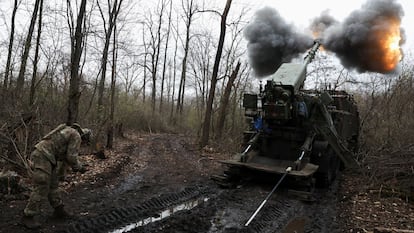Ukraine accelerates weapons production: ‘We produce more howitzers than all of Europe combined’
Foreign financing of domestic industry, which has largely replaced the delivery of equipment, is key to the growth of the defense sector. Ukrainian-made weapons now cover a third of the army’s needs


The conflict in Ukraine has already written a new chapter in the history of warfare due to the mass production and use of drones. An incontestable and striking revolution, but one that both the trenches and the defense industry underline: no war is won with these unmanned aircraft alone. The combat front is still maintained today by conventional weapons. Among them, the 2S22 Bohdana howitzer is gaining prominence, a technical name that conceals a fundamental element of the transformation in national weapons manufacturing. Before Russia attacked in February 2022, this cannon, manufactured by a company in Kramatorsk, had completed a handful of tests. There were even fears that the model would fall into the hands of Russian troops. Three years later, production of this weapon surpasses that of Kyiv’s major European allies, a giant step forward in the autonomy of the Ukrainian defense industry, which now covers a third of the army’s needs — largely with foreign funding — according to government data.
This type of artillery piece is highly prized. It is a self-propelled howitzer mounted on a wheeled chassis with 155-millimeter ammunition, a standard NATO caliber and therefore widely used in the field of operations thanks to contributions from international partners. Ukraine has also accelerated production of these shells. The 2S22 Bohdana has a range of up to 42 kilometers (26 miles). In practice, it is a weapon used intensively due to its mobility and destructive potential. Its first major success, in the summer of 2022, was the recapture of Snake Island in the Black Sea, in collaboration with French-made Caesar howitzers.
But after that milestone, its impact has been measured. Russia was pressing on the front lines and Ukraine, while trying to stretch production at KZVV (Kramatorsk Heavy Duty Machine Tool Building Plant), manufacturer of the 2S22 Bohdana, needed the cannons of its allies. Military analyst Patrick Hinton of the UK-based Royal United Services Institute estimated that there were 14 howitzer models in the Ukrainian army’s possession by July 2023, during the counteroffensive, when any country’s military typically has two or three. The Ukrainian howitzer type lacked the funding to scale up quickly, and it also suffered from technical obstacles with the chassis that supports the cannon.
Igor Fedirko, director of the Ukrainian Council of Defense Industry (UCDI), states simply the reason for the increase in production: “The main reason is that we need them for war.” The numbers speak for themselves. Last October, Ukrainian President Volodymyr Zelenskiy reported that manufacturing capacity had reached 20 units per month. Six months later, the sector estimates that figure is around 40. A particularly weighty number because it is similar to that recorded in Russia, according to a September report by the Kiel Institute.
This same report indicates that France, for example, produces eight units of its cannon model per month; and Germany, five or six. “We produce more howitzers than all of Europe combined,” Fedirko asserts, with good access to private industry and the needs of the front. The growth achieved by the 2S22 Bohdana howitzer symbolizes the radical change experienced by arms production, once dependent on the state-owned company Ukroboronprom. Public funding, the entry of private companies, and, above all, international support have boosted the sector. According to government data, the defense industry’s capacity has multiplied 35-fold in three years and will reach $35 billion by 2025.
Fedirko, a former advisor to the Ministry of Strategic Industries, cites another key factor in this growth of “made in Ukraine” howitzers: the so-called “Danish model.” Faced with a lack of military hardware to deliver to Ukraine, the Danish government proposed last July shifting toward sending funds so that Ukrainian arms companies could manufacture their weapons within the country. Part of that money — €538 million ($588 million) last year alone — was used for the production of the 2S22 Bohdana.
The process of this Danish initiative is as follows: the Ukrainian government submits a list of military projects to be financed, and Danish experts analyze their feasibility and the performance guarantees of the Ukrainian companies developing the weapon. Copenhagen has also opened this kind of financing umbrella to other actors. Funds have flowed through this new channel from Sweden and Iceland, as well as from the EU, through the accumulated interest income from frozen Russian assets. Norway and Canada have also committed capital to this initiative. “I am amazed by the speed with which the Ukrainian defense industry is able to deliver its services,” Danish Defense Minister Troels Lund said last January. The model works, so Denmark announced on January 3 a new package of almost €900 million ($985 million) for the period 2025-2027.
“Ukraine has exponentially increased its military production over the past three years,” says Mykola Bielieskov, a senior analyst at the Kyiv-based National Institute for Strategic Studies, “especially in various types of unmanned aerial vehicles (reconnaissance and attack), howitzers, cruise missiles, mortars, and armored personnel carriers.” According to Bielieskov, the infusion of foreign funding into domestic production also allows for “more economical production, due to lower labor costs,” and “faster production” because it directly responds to the needs of the front, which serves as a testing ground for each weapon and its modifications.
The progress of this industry, amid a brutal invasion, is spectacular, but the dependence on international partners, both for heavy weapons (air defense systems, for example) and components (microelectronics, explosives, missile propellant), is still very high. There is also the risk of a long-term decline in funding or skilled labor, as Bielieskov points out. The recipe is clear: first, the front line. But without losing sight of the sector’s long-term potential in the international market. “The potential of Ukraine’s defense industry is enormous,” Fedirko notes, “and it is ready for export.” Partnership agreements between Ukrainian and foreign companies are being sought. This is already happening. The German company Rheinmetall and the Franco-German company KNDS, both focused on ammunition production, and the American company AeroVironment, which manufactures drone-bombs, have launched operations in Ukraine.
Sign up for our weekly newsletter to get more English-language news coverage from EL PAÍS USA Edition
Tu suscripción se está usando en otro dispositivo
¿Quieres añadir otro usuario a tu suscripción?
Si continúas leyendo en este dispositivo, no se podrá leer en el otro.
FlechaTu suscripción se está usando en otro dispositivo y solo puedes acceder a EL PAÍS desde un dispositivo a la vez.
Si quieres compartir tu cuenta, cambia tu suscripción a la modalidad Premium, así podrás añadir otro usuario. Cada uno accederá con su propia cuenta de email, lo que os permitirá personalizar vuestra experiencia en EL PAÍS.
¿Tienes una suscripción de empresa? Accede aquí para contratar más cuentas.
En el caso de no saber quién está usando tu cuenta, te recomendamos cambiar tu contraseña aquí.
Si decides continuar compartiendo tu cuenta, este mensaje se mostrará en tu dispositivo y en el de la otra persona que está usando tu cuenta de forma indefinida, afectando a tu experiencia de lectura. Puedes consultar aquí los términos y condiciones de la suscripción digital.

